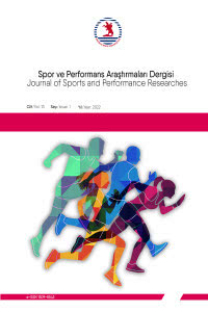FİZİKSEL PERFORMANS DÜZEYİ EMPATİ VE SPORTMENLİĞİ ETKİLER Mİ?: ELİT KADIN VOLEYBOLCULAR ÜZERİNE BİR ARAŞTIRMA
empati, Fiziksel performans, prososyal davranış., sportmenlik
DOES PHYSICAL PERFORMANCE LEVEL AFFECT EMPATHY AND SPORTSPERSONSHIP?: A STUDY ON ELITE FEMALE VOLLEYBALL PLAYERS
Empathy, Physical performance, Prosocial behaviour, Sportspersonship,
___
- 1. Bayraktar B, Kurtoğlu M. Sporda performans ve performans artırma yöntemleri. İstanbul, 2004.
- 2. Güvel H, Kayatekı̇n M, Acarbay Ş, Özgönül H. Genç erkek sporcularda vücut yağ oranı ı̇le fiziksel ı̇ş kapasite arasındaki ı̇lişki, Performans Dergisi, 1996; 2 (3): 118.
- 3. Reneman MF, Fokkens AS, Dijkstra PU. Testing lifting capacity: Validity of determining effort level by means of observation. Spine, 2005; 30 (2): 40-46.
- 4. Rogers CR. Empatik olmak değeri anlaşılmamış bir varoluş şeklidir. Çeviri, Akkoyun F. Ankara Üniversitesi Eğitim Bilimleri Fakültesi Dergisi 1983; 16 (1): 103-121.
- 5. Shields DL, Funk CD, Bredemeier BL. Contesting orientations: Measure construction and the prediction of sportspersonship. Psychology of Sport and Exercise, 2015; 2: 1-10.
- 6. Sezen-Balçıkanlı G, Yıldıran İ. Sportspersonship orientation and empathy: A study of professional football players. Journal of Physical Education and Sport (JPES), 2012; 12 (1): 18-24.
- 7. Sezen-Balçıkanlı G, Sezen M. The relationship between empathy and antisocial-prosocial behaviours in youth field hockey players. International Journal of Learning and Change, 2019; 11 (1): 57-65.
- 8. Sezen-Balçıkanlı G. Fair play and empathy: A research study with student teachers. Journal of US-China Public Administration, 2009; 6(4): 79-84.
- 9. Goleman D. Duygusal zekâ neden iq’ dan daha önemlidir? İstanbul, Varlık-Bilim, 1998.
- 10. Hoffman ML. The contribution of empathy to justice and moral judgment. In: Esinberg N, Strayer J, editors, Empathy and Its development. New York: Cambridge University Press; 1990.
- 11. Stornes T, Ommundsen Y. Achievement Goals, Motivational Climate and Sportspersonship: A Study of Young Handball Players. Scandinavian Journal of Education, 2004; 48 (2): 205-221.
- 12. Sezen-Balçıkanlı G, Yıldıran İ. Profesyonel futbolcuların sportmenlik yönelimleri ve empatik eğilim düzeyleri. Spormetre Beden Eğitimi ve Spor Bilimleri Dergisi, 2011; 9 (2), 49-56.
- 13. Sezen-Balçıkanlı G, Sezen M. Professional sports and empathy: Relationship between professional futsal players’ tendency toward empathy and fouls. Physical Culture and Sport. Studies and Research, 2017; 73 (1), 27-35.
- 14. Stornes T, Bru E. Sportspersonship and perceptions of leadership: An investigation of adolescent handball players' perceptions of sportspersonship and associations with perceived leadership. European Journal of Sport Science, 2002; 2 (6): 1-15.
- 15. Sezen-Balçıkanlı G, Yıldıran İ. Elit salon hokeyi oyuncularında empatik beceri ile prososyal davranışlar arasındaki ilişki. Gazi Beden Eğitimi ve Spor Bilimleri Dergisi, 2018; 23 (1): 1-8.
- 16. Kavussanu M, Boardley ID. The prosocial and antisocial behavior in sport scale. Journal of Sport and Exercise Psychology, 2009; 31 (1): 97-117.
- 17. Sezen-Balçıkanlı G. The Turkish adaptation of the prosocial and antisocial behavior in sport scale (PABSS). Int J Humanit Soc Sci, 2013; 3(18): 271-6.
- 18. Davis MH. Measuring individual differences in empathy: Evidence for a multidimensional approach. Journal of personality and social psychology, 1983; 44 (1): 113.
- 19. Engeler A. Psikopati ve antisosyal kişilik bozukluğu, İstanbul Üniversitesi, Yayınlanmamış Doktora Tezi, 2005.
- 20. Al-Yaaribi A, Kavussanu M, Ring C. The effects of prosocial and antisocial behaviors on emotion, attention, and performance during a competitive basketball task. Journal of Sport and Exercise Psychology, 2018; 40 (6): 303-311.
- 21. Al-Yaaribi A, Kavussanu M, Ring C. Consequences of prosocial and antisocial behavior for the recipient. Psychology of Sport and Exercise, 2016; 26: 102-112.
- 22. Bolter ND, Weiss MR. Coaching behaviors and adolescent athletes' sportspersonship outcomes: Further validation of the sportsmanship coaching behaviors scale (SCBS). Sport, Exercise, and Performance Psychology, 2013; 2 (1): 32.
- ISSN: 1309-5110
- Yayın Aralığı: Yılda 3 Sayı
- Başlangıç: 2010
- Yayıncı: Ondokuz Mayıs Üniversitesi Yaşar Doğu Spor Bilimleri Fakültesi
Nimet GÜRSEL, Pınar GÜZEL, Kadir YILDIZ
SPOR ETKİNLİKLERİNE YÖNELİM ÖLÇEĞİNİN TÜRKÇE GEÇERLİK VE GÜVENİRLİK ÇALIŞMASI
Hüseyin ÇEVİK, Kerem Yıldırım ŞİMŞEK, Anıl Onur MERCANOĞLU, Alican BAYRAM
SPOR YAPAN VE YAPMAYAN LİSE ÖĞRENCİLERİNİN SOSYAL BECERİ DÜZEYLERİNİN İNCELENMESİ: ISPARTA ÖRNEĞİ
Mehmet Emin KOCA, Olcay SALİCİ
ELİT VOLEYBOLCULARDA SERVİS ÇEŞİDİ, POZİSYON VE CİNSİYETİN SERVİS HIZINA ETKİSİ
Özge ÇINAR MEDENİ, Cengiz AKARÇEŞME, Şenay ÇEREZCİ, Nihan ÖZÜNLÜ PEKYAVAŞ, Fatma Filiz ÇOLAKOĞLU, Gül BALTACI
GÖRME ENGELLİ FUTBOL VE FUTSALCILARIN MÜSABAKA ÖNCESİ DURUMLUK KAYGI DÜZEYLERİNİN İNCELENMESİ
Mehmet YAZICI, Recep ÖZ, Yasemin ÇAKMAK YILDIZHAN, Harun BÜYÜKYILDIRIM
Yasin ARSLAN, Gülfem SEZEN BALÇIKANLI
8-10 YAŞ GRUBU YÜZÜCÜLERİN 25M FARKLI STİL YÜZME PERFORMANSLARININ MOTORİK ÖZELLİKLER İLE İLİŞKİSİ
Benil KISTAK, Çiğdem BULGAN, Bergün Meriç BİNGÜL, Mustafa Arslan BAŞAR
